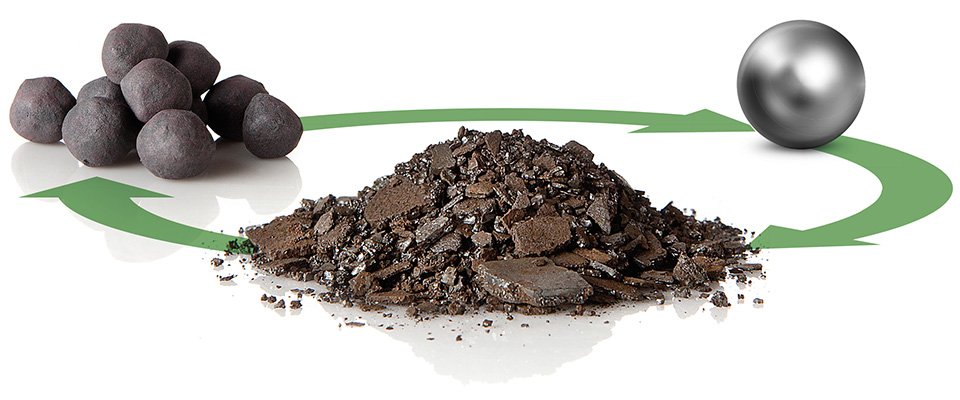We use cookies to improve how you experience our website. Read more about our GDPR-policy here.

We pave the way for a circular paradigm
It´s high time for the historically deep-rooted, linear logic of the metals and mining sector to be transformed. We want to pave the way for a circular paradigm by producing valuable commodities from residues and waste. The goal is to radically reduce the entire metal industry’s climate footprint.
We want to contribute to creating a completely CO2-free value chain, from the extraction of ore to the production of steel and various metals. If our industry is to succeed, we see it as unavoidable that the flow of metals from the mine to the landfill are replaced by recycling. Unlike many natural resources, metals don´t lose quality by being used, ground down, melted or dissolved. They can always be reset and regain their original properties an infinite number of times.
Our customers
Our customer as well as supplier group is the mining, steel, foundry, and manufacturing industries. As part of the recycling industry we can take by-products, such as residuals and waste, from the industry and turn them into usable metals again. With our CO2-free technology we believe we can create a new green business segment in the existing metals and mining market.
GreenIrons Value Proposition
Our mission is to contribute to a historic reduction in CO2-emissions from the production of iron, steel and non-ferrous metals – a sector that accounts for approx. 8%* of the global greenhouse gas emissions.
Our value proposition is to deliver CO2-free materials in order for our customers and us to fulfill the objective of building a cleaner future for our planet.
CO2-free process
- We use fossil free hydrogen as reducing agent. This means that water becomes the only by-product, instead of the emissions of carbon dioxide in traditional reduction processes. One GreenIron furnace is expected to reduce CO2-emissions by approx. 56,000 tonnes** per year.
- The metals and mining industry often considers residuals as waste in the production process, which is commonly encapsulated in landfills or become slag heaps. With our technology we can recycle these materials, converting them to valuable commodities.
- Our recycling-oriented business model is focused on reducing unsustainable mining of finite natural resources. However, our scalable technology also allows processing of virgin raw materials into pure metals. This is to meet the increased demand for both base metals and critical minerals, due to the necessary, global green transition.
Energy efficiency
- Our technology is energy efficient as it works with three forces of nature: temperature, pressure, and gravity. By installing multiple furnaces on one site, heat and gas can be recycled between different furnaces. The heat and gas from one process can therefore be recycled to the next process with minimal waste.
- Our process is a closed system which is internally circular. The incoming gas is heated by the outgoing hydrogen gas and is recirculated within the system. This means the hydrogen consumption is minimal in the process and decreases the energy costs.
- The main operating cost is the production of hydrogen gas. The consumption of hydrogen is related to the input material, its amount, and gas leakage/waste, which is kept to the minimum through the technological design.
Flexibe technology
- The process is cycle-based, which makes it possible to vary the input material from batch to batch. In other words, the first batch may consist of oxidised scale-based pellets, the second of grinding swarf, the third of magnetite, etc. Therefore, it´s possible to produce pellets with specific alloys at a low cost.
- Our production process is scalable, which is one of our most sustainable advantages in a new, growing market. We can adapt the capacity entirely to our customers’ needs, whether it´s a single furnace or e.g. 10 interconnected furnaces. In practice, this example implies an option for our customers to process from 40,000 to 430,000 tonnes of oxidised material/year.
- The possibility of small-scale solutions means that our furnaces can be placed locally, in connection with steel and rolling mills, foundries, mines, etc., just about anywhere on our globe. This will mean a radically reduced need for energy-consuming transports in the industry.
Sustainable profitability
- Our process is both energy efficient and profitable for multiple materials, such as iron, copper, and nickel oxides. Due to the modularity of our solution, the threshold for investing in a first furnace is low. It is possible to invest in a 2nd, 3rd furnace later, to gradually reduce emissions of carbon dioxide and to become more circular.
- The profitability when reducing iron or other metals is proportional to the main operating cost, the cost of hydrogen. As the price of hydrogen decreases, the overall profitability of our process will increase over time.
- The most important driving force in our energy-efficient technology is that we use three laws of nature. This means that the temperature is relatively low throughout the process. Installing several furnaces in one facility enables energy sharing, which means that costly energy consumption can be reduced.
* https://ourworldindata.org/emissions-by-sector
** We compare the CO2-emissions from reduction using carbon in blast furnaces, which ranges from 1.8 to 3.0 tonnes CO2 per tonne iron. The annual production of one furnace is 28 000 tonnes direct reduced iron without CO2-emissions. For ease of calculation and targeting the more efficient blast furnaces, we therefore calculate with 2 tonnes CO2 per tonne direct reduced iron, resulting in 56 000 tonnes CO2 from a traditional blast furnace. Our furnace has no CO2-emissions.